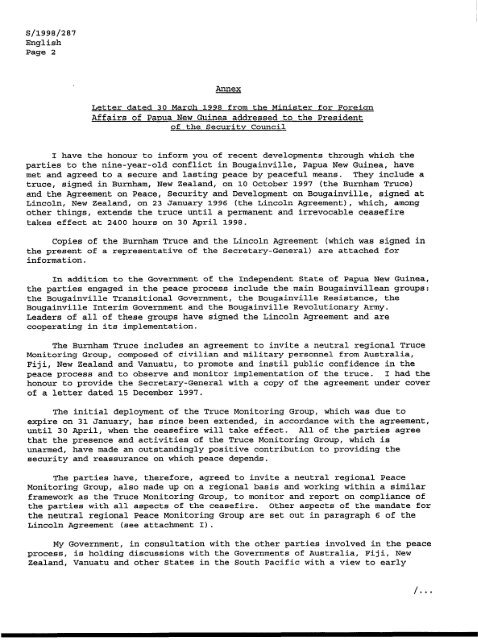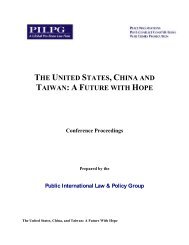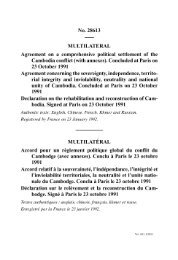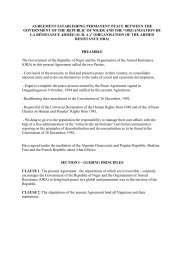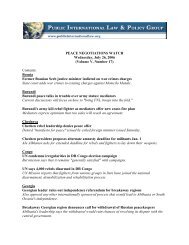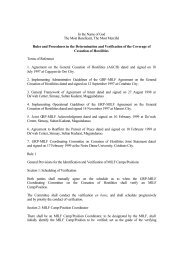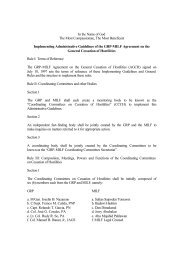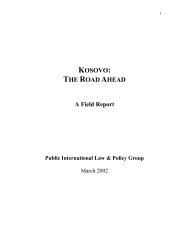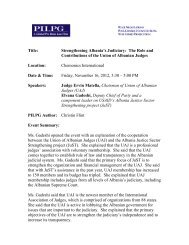The Burnham Truce - Public International Law & Policy Group
The Burnham Truce - Public International Law & Policy Group
The Burnham Truce - Public International Law & Policy Group
Create successful ePaper yourself
Turn your PDF publications into a flip-book with our unique Google optimized e-Paper software.
S/1998/287<br />
English<br />
Page 2<br />
Annex<br />
Letter dated 30 March 1998 from the Minister for Foreign<br />
Affairs of Papua New Guinea addressed to the President<br />
of the Security Council<br />
I have the honour to inform you of recent developments through which the<br />
parties to the nine-year-old conflict in Bougainville, Papua New Guinea, have<br />
met and agreed to a secure and lasting peace by peaceful means. <strong>The</strong>y include a<br />
truce, signed in <strong>Burnham</strong>, New Zealand, on 10 October 1997 (the <strong>Burnham</strong> <strong>Truce</strong>)<br />
and the Agreement on Peace, Security and Development on Bougainville, signed at<br />
Lincoln, New Zealand, on 23 January 1996 (the Lincoln Agreement), which, among<br />
other things, extends the truce until a permanent and irrevocable ceasefire<br />
takes effect at 2400 hours on 30 April 1998.<br />
Copies of the <strong>Burnham</strong> <strong>Truce</strong> and the Lincoln Agreement (which was signed in<br />
the present of a representative of the Secretary-General) are attached for<br />
information.<br />
In addition to the Government of the Independent State of Papua New Guinea,<br />
the parties engaged in the peace process include the main Bougainvillean groups:<br />
the Bougainville Transitional Government, the Bougainville Resistance, the<br />
Bougainville Interim Government and the Bougainville Revolutionary Army.<br />
Leaders of all of these groups have signed the Lincoln Agreement and are<br />
cooperating in its implementation.<br />
<strong>The</strong> <strong>Burnham</strong> <strong>Truce</strong> includes an agreement to invite a neutral regional <strong>Truce</strong><br />
Monitoring <strong>Group</strong>, composed of civilian and military personnel from Australia,<br />
Fiji, New Zealand and Vanuatu, to promote and instil public confidence in the<br />
peace process and to observe and monitor implementation of the truce. I had the<br />
honour to provide the Secretary-General with a copy of the agreement under cover<br />
of a letter dated 15 December 1997.<br />
<strong>The</strong> initial deployment of the <strong>Truce</strong> Monitoring <strong>Group</strong>, which was due to<br />
expire on 31 January, has since been extended, in accordance with the agreement,<br />
until 30 April, when the ceasefire will take effect. All of the parties agree<br />
that the presence and activities of the <strong>Truce</strong> Monitoring <strong>Group</strong>, which is<br />
unarmed, have made an outstandingly positive contribution to providing the<br />
security and reassurance on which peace depends.<br />
<strong>The</strong> parties have, therefore, agreed to invite a neutral regional Peace<br />
Monitoring <strong>Group</strong>, also made up on a regional basis and working within a similar<br />
framework as the <strong>Truce</strong> Monitoring <strong>Group</strong>, to monitor and report on compliance of<br />
the parties with all aspects of the ceasefire. Other aspects of the mandate for<br />
the neutral regional Peace Monitoring <strong>Group</strong> are set out in paragraph 6 of the<br />
Lincoln Agreement (see attachment I ) .<br />
My Government, in consultation with the other parties involved in the peace<br />
process, is holding discussions with the Governments of Australia, Fiji, New<br />
Zealand, Vanuatu and other states in the South Pacific with a view to early<br />
/...


